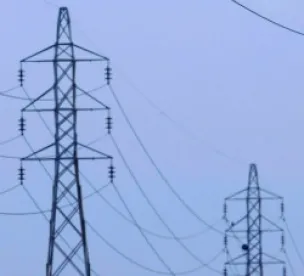The U.S. Army Corps of Engineers (USACE) has proposed revisions to its Nationwide Permits (NWPs) that will significantly change to how utility lines will be treated under the NWP program. Currently, only one NWP exists to address the construction of all utility lines: NWP 12. The USACE proposes to add two new utility line permits: NWP C: Electric Utility Line and Telecommunications Activities and NWP D: Utility Line Activities for Water and Other Substances. The USACE further intends to limit existing NWP 12 to only oil and natural gas activities. Finally, the USACE has proposed to further reduce the regulatory obstacles faced by wind and solar project developers by modifying additional NWPs.
The key changes relevant to wind and solar developments are the creation of NWP C, the elimination of many Pre-Construction Notification requirements, and the removal of the 300 linear foot limit for losses to stream bed in NWP 51. This alert discusses those changes in more detail below.
THE NATIONWIDE PERMIT PROGRAM
NWPs are permits used by the USACE to permit a wide range of activities that, upon incorporation of identified conditions and mitigation measures, have been determined to result in minimal adverse effects to the environment. NWPs are useful for project applicants because they streamline the permitting processes necessary for USACE approval. In many cases, NWPs eliminate the need for public notice, environmental review under the National Environmental Policy Act, state agency review under the Clean Water Act, and consideration of conditions and mitigation measures because these issues are addressed programmatically as part of the NWP. While the current NWPs are authorized through 2022, USACE has taken the unusual step of seeking early reauthorization of the existing NWPs and approval of several new NWPs.
NATIONWIDE PERMIT 12
The USACE proposes modifying NWP 12 by dividing the current NWP 12 into three separate permits and reducing the Pre-Construction Notification (PCN) requirements for them all.1 The current NWP 12 will be repurposed to authorize only oil and natural gas pipeline activities and will be renamed “Oil or Natural Gas Pipeline Activities.” Two new NWPs will address projects previously approved under NWP 12: NWP C: Electric Utility Line and Telecommunications Activities and NWP D: Utility Line Activities for Water and Other Substances. Those new permits are addressed in greater detail below.
The most significant and potentially the most controversial change to NWP 12 is the elimination of most of the existing PCN requirements.2 PCN requirements generally govern when a project proponent must notify the USACE prior to commencing construction under a NWP to confirm that the project complies with the NWP.
The revised NWP 12 will no longer require a PCN in several situations where one was previously required under previous versions of NWP 12: (1) activities involving mechanized land clearing in a forested wetland for the utility line right-of-way; (2) utility lines in waters of the United States, excluding overhead lines, exceeding 500 feet; (3) utility lines placed within a jurisdictional area (i.e., water of the United States), running parallel to or along a stream bed that is within that jurisdictional area; (4) permanent access roads constructed above grade in waters of the United States for a distance of more than 500 feet; and (5) permanent access roads constructed in waters of the United States with impervious materials.3
The revised NWP 12 seeks to simplify the PCN requirements by only requiring a PCN in the following circumstances: (1) if a permit is required under Section 10 of the Rivers and Harbors Act (RHA) (associated with work and installation of structures in navigable waters of the United States); (2) if the discharges will result in the loss of greater than 1/10-acre of waters of the United States; or (3) if the proposed pipeline is greater than 250 miles in length and the purpose of the project is to install a new pipeline.4 Other than the modifications to the PCN requirements discussed above, the USACE intends to retain the basic structure of the 2017 NWP 12.
NATIONWIDE PERMIT C: ELECTRIC UTILITY LINE AND TELECOMMUNICATION ACTIVITIES
The basic structure of the new NWPs C and D are very similar to the 2017 NWP 12, since many of the activities authorized by the 2017 NWP 12 could apply to any utility line, regardless of what substance it conveys.5 The USACE is proposing to create NWP C to authorize electric utility line and telecommunications activities.6 This permit will authorize activities required for the construction, maintenance, repair, and removal of electric utility lines, telecommunication lines, and associated facilities in waters of the United States, provided the activity does not result in a loss of greater than 1/2-acre of waters of the United States for each single and complete project. The permit defines an “electric utility line and telecommunications line” as any cable, line, or wire for the transmission for any purpose of electrical energy, telephone, and telegraph messages, and internet, radio, and television communication.7
The permit provides for discharge of dredge or fill material in connection with the construction of electric utility lines and telecommunication lines. NWP C also authorizes the construction, maintenance, or expansion of substation facilities associated with electric utility lines in non-tidal waters of the United States, but does not authorize discharges into non-tidal wetlands adjacent to tidal waters. Construction or maintenance of foundations for overhead electric utility lines, poles, and anchors is also authorized, provided the foundations are the minimum size necessary and separate footings for each tower leg (rather than a larger single pad) are used where feasible. Finally, NWP C also authorizes the construction of access roads for the construction and maintenance of electric utility lines or telecommunication lines in non-tidal waters of the United States.8
NWP C may authorize electric utility lines or telecommunication lines in or affecting waters of the United States even if there is no associated discharge of dredged or fill material. However, such utility lines that are constructed over or routed under navigable waters of the United States without a discharge of dredged or fill material still require a permit under Section 10 of the RHA.9 Finally, NWP C would require PCN if the following thresholds are met: (1) if a Section 10 permit is required or (2) if the discharge will result in the loss of greater than 1/10-acre of waters of the United States.10
NATIONWIDE PERMIT D: UTILITY LINE ACTIVITIES FOR WATER AND OTHER SUBSTANCES
The USACE is also proposing to create NWP D, which would authorize activities required for the construction, maintenance, repair, and removal of utility lines for water and other substances, excluding oil, natural gas, and electricity.11 NWP D will authorize associated utility line facilities in waters of the United States, provided the activity does not result in the loss of greater than 1/2-acre of waters of the United States for each single and complete project.
NWP D will authorize discharges of dredged or fill material into waters of the United States and structures or work in navigable waters for crossing of those waters associated with the construction, maintenance, or repair of utility lines for water or other substances, including outfall and intake structures. A “utility line” is defined as any pipe or pipeline for the transportation of any gaseous, liquid, liquescent, or slurry substance, for any purpose that is not oil, natural gas, or petrochemicals.12
NWP D also authorizes the construction, maintenance, or expansion of substation facilities associated with a utility line in non-tidal waters; the construction or maintenance of foundations for above-ground utility lines in all waters of the United States, provided the foundations are the minimum size necessary; and the construction of access roads for the construction and maintenance of utility lines. However, NWP D will not authorize discharges into non-tidal wetlands adjacent to tidal waters for access roads.13
A PCN is required under NWP D if (1) a Section 10 permit is required or (2) the discharge will result in the loss of greater than 1/10-acre of waters of the United States.
NATIONWIDE PERMIT 14: LINEAR TRANSPORTATION PROJECTS
The USACE is proposing a minor change to NWP 14, Linear Transportation Projects. “Driveways” will be added to the list of examples of the types of linear transportation projects authorized by NWP 14, to clarify that the construction or expansion of driveways can be authorized by NWP 14.14
NATIONWIDE PERMIT 33: TEMPORARY CONSTRUCTION, ACCESS, AND DEWATERING
The USACE is considering whether it can use its existing authority to create specific procedures or conditions by which Federal agencies that currently require a NWP would not need to submit a PCN. NWP 33 is one of the permits for which the USACE is considering removing PCN requirements for Federal applications. The USACE is seeking comments on whether to limit PCN requirements to non-federal permittees.15
NATIONWIDE PERMIT 51: LAND-BASED RENEWABLE ENERGY GENERATION FACILITIES
The USACE proposes to modify NWP 51, Land-Based Renewable Energy Generation Facilities, by removing the 300 linear foot limit for losses to stream bed.16 The USACE will instead rely on the 1/2-acre limit and PCN requirements to ensure that activities authorized by NWP 51 result in no more than minimal adverse environmental effects.
The USACE proposes to remove the provision in NWP 51 allowing district engineers to waive the 300 linear foot limit for losses of intermittent and ephemeral stream bed in connection with a PCN request for a waiver of that 300 linear foot limit.17 The USACE is also proposing to remove the agency coordination process between federal and state agencies when a district engineer receives a request to waive the 300 linear foot limit.18 These revisions are being made in light of the final rule defining “waters of the United States,” which categorically excluded ephemeral streams from USACE jurisdiction under the Clean Water Act.19 As such, no need exists to request a waiver for losses to ephemeral stream bed because NWP authorization is unnecessary for discharge or fill into waters not subject to the Clean Water Act.20
Finally, the USACE is proposing to change the reference in Note 1 of NWP 51 to proposed NWP C and to clarify in Note 3 that the Corps district, not the permittee, will send a copy of the NWP PCN and/or verification to the Department of Defense Siting Clearinghouse.21
IMPLICATIONS FOR WIND AND SOLAR PROJECTS
The proposed NWP C and D will have the greatest impacts on wind and solar projects. If issued under their proposed framework, the new nationwide permits specific to electric transmission activities or other utility line activities will streamline the NWP approval process for wind and solar generation projects by consolidating into one permit application those activities that might have previously have been authorized under both NWP 12 and 51. Additionally, the removal of many of the criteria for PCN will consolidate and simplify the PCN process, expedite project timelines for projects that do not require submission of a PCN, and allow project proponents to tailor their submissions to more effectively to address environmental impacts created by renewable energy projects.
Once the proposed rule is published in the Federal Register, the comment period will be open for 60 days. Interested parties in the wind and solar industries are encourage to submit comments on the proposed changes, including statements of support or recommendations on how the NWPs can be improved.
1 Proposal to Reissue and Modify Nationwide Permits, Prepublication Version at 63–64 (hereinafter “Pre-publication Rule”), available here.
2 Pre-publication Rule at 70, 125, 128.
3 Pre-publication Rule at 70.
4 Pre-publication Rule at 188.
5 Pre-publication Rule at 67.
6 Pre-publication Rule at 124–25.
7 Pre-publication Rule at 222–23.
8 Pre-publication Rule at 222–23.
9 Pre-publication Rule at 223.
10 Pre-publication Rule at 224.
11 Pre-publication Rule at 225.
12 Pre-publication Rule at 225.
13 Pre-publication Rule at 226.
14 Pre-publication Rule at 78.
15 Pre-publication Rule at 17.
16 Pre-publication Rule at 36.
17 Pre-publication Rule at 36–37.
18 Pre-publication Rule at 38.
19 See 33 C.F.R. 328.3.
20 Pre-publication Rule at 37.
21 Pre-publication Rule at 115–16.






 />i
/>i

